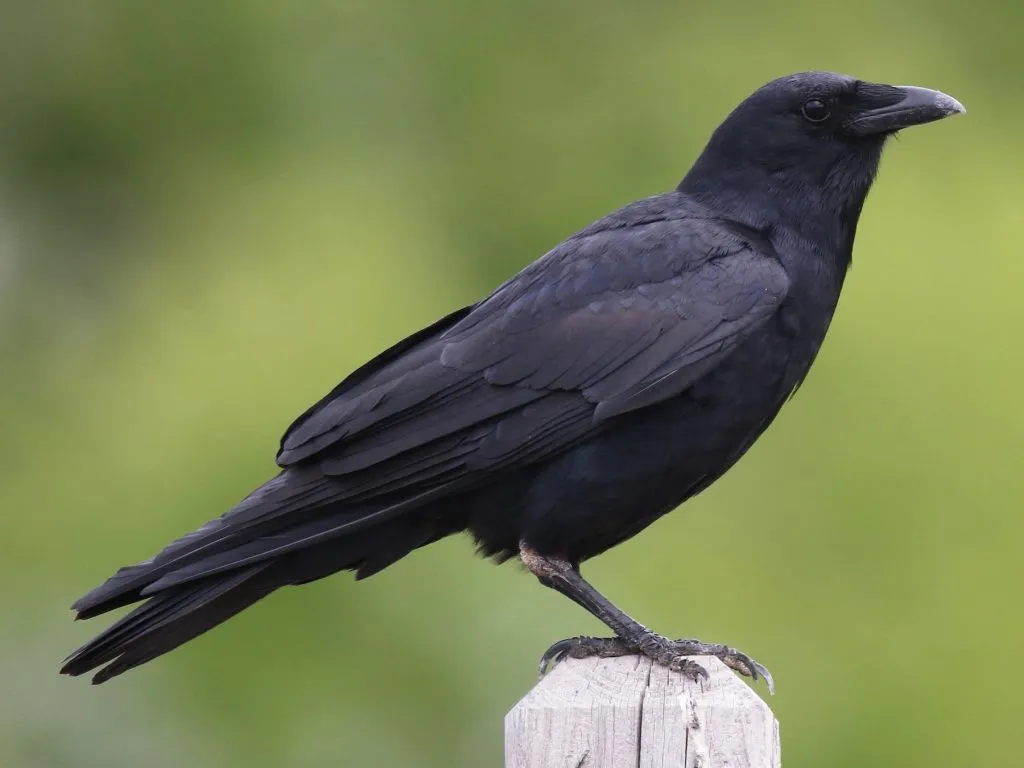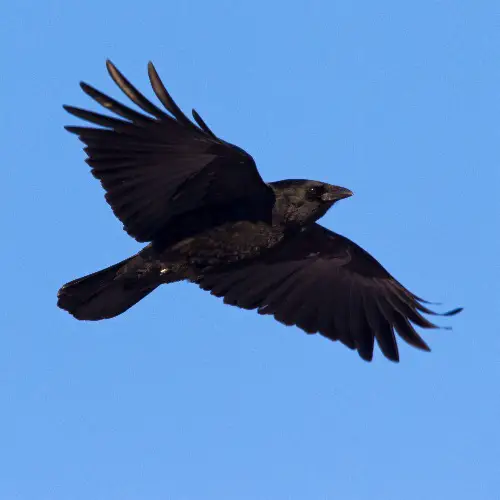Last Updated on: February 4, 2025
I never thought I’d be interested in attracting crows to my backyard until I saw them in the wild and loved their quirky but intelligent behavior.
They have this unmistakable crow call that you can never confuse with the call of other avians.
Beyond marveling at the dark plumage of these birds, what else can they offer you?
Well…
For starters, crows forage in the garbage; therefore, they assist in pest control. So, here’s how to attract crows without making so many changes to your yard.
How To Attract Crows To Your Backyard
Crows aren’t backyard birds. However, they interact with humans almost daily because some species live in towns and parks. Here are a few ideas to guide you as you create a strategy to attract crow species to your garden.
Can They Roost In Your Yard?
One of the first concerns when attracting crows is the size of the property and how easy it is for these avians to roost.
If you don’t have telephone wires, posts, or fence posts, erect a few posts as crows like to observe the area from a telephone pole or fence.
An ideal perch could even be a crossbar extending from a branch on a tree to your backyard fence.
Aso, erect these posts at a vantage point for you to watch these avians without leaving your deck.
1. Offer Bird Food
Crow species eat a wide range of foods. You may not know what foods they love in your first attempt since these aren’t regular backyard birds. But, we mentioned that a crow perches on a telephone pole from where it surveys the ground.
Use this to your advantage and offer eye-catching bird food like shelled peanuts as they are easy to see from a treetop, and crows love them.
You can scatter unsalted peanuts on the ground where crows can see them from your fence or the trees in your backyard.
Alternatively, use a platform feeder to feed crows while attracting other ground-feeding larger birds. You might have to move your bird feeder severally until crows see it or gain your trust to fly down from a perch. Later on, you can feed them nuts, pasta, eggs, and pet food.
When they start coming into your yard regularly, introduce a feeding routine to make the process easy for you. It’ll also win the trust of crows as they’ll know when to expect rations.
Even as you do that, note other birds, squirrels, and predators using the same bird feeder to make feeding birds cost-effective. There’s no need to refill if you’re only attracting one crow while feeding squirrels and pets. If that happens, squirrel-proof the bird feeder and keep your pets out of the yard as they might chase crows away.
2. Tone The Noise Down
It’s so strange that a bird that makes loud caws, coos, and rattles doesn’t like noisy habitats.
You’ll have to remove bells, oil your door hinges, and listen for other random sounds.
You might not even know such sounds exist, so once crows land in your yard, watch to see if some random noises will spook the feeding birds.
3. Play Crow Calls
Birds use calls all the time for different communication needs. For instance, they may make a distress call alerting a flock about a predator. You’d need to know the purpose of the crow call before playing it to avoid using a distress call.
Also, use a crow call after toning down other noises in your backyard.
4. Install A Bird Bath
Water is another essential feature when attracting crows because these social birds love hanging around birdbaths!
They do everything there — from drinking to bathing and cooling off during summer.
But these won’t be the usual bird baths for other species as crows are large birds. For instance, an American crow measures 15.8 to 20.9 inches long from bill to tail, and it weighs between 11.2 and 21.9 ounces. They need a sturdy, deep birdbath. You can install another one for smaller birds a short distance away.
5. Use A Fake Crow
Mount fake crows to invite the real ones by showing them your yard is already crow-friendly. For instance, mount a decoy crow on a tree branch or near a birdbath where the real crows may perch so that you can entice them to join the “flock.”
The real crows will feel less threatened and assume crow decoys have found a suitable roosting ground.
A fake crow also works because crows move in groups, so when one decides to explore your backyard, a murder settles there. Yes, murder means a group of crows. But, you’d need at least one moving fake crow because if they’re all stationary, the real crows won’t buy your idea.
These fakes are affordable and easy to find in hardware stores. On top of that, once you attract crows, you can use the fakes as decor pieces indoors or on your deck.
6. Display Shiny Objects
Crows like shiny objects and often carry them to their nests.
Since shiny objects may drive away fussy birds, attract crow species with this strategy when others fail. Even as you try different ways and learn how to attract crows to your yard, don’t forget they are wild birds that you shouldn’t interact with closely.
Watch them from your deck and refill the feeder when there’s less bird activity in your yard.
Which Species Are You Attracting?
It’s easier to choose a method to attract crows when you know the species in your area. We’ll only talk about the ones you’re likely to see in North America, starting with:
1. American Crow

You’ll find it anywhere in North America except in the southwestern desert. Its breeding range is in Canada, Alaska, and other northern areas, while the wintering grounds are in parts of Texas, California, Utah, and Nevada. Baby crows live in nests near a tree trunk in evergreen or deciduous forests.
You’ll see this crow in towns, fields, and by the roadside. It’s almost like it lives everywhere, even on beaches, but not in backyards. Drawing it to your home can eliminate carrion, crop pests, and mice. But, you’ll risk the eggs of small birds like robins and jays as American crows raid nests.
2. Fish Crow

It’s not as common as the American crow because it inhabits the southeastern edge of North America, from Louisiana to Delaware, only. But, you can attract fish crows to your backyard any time of the year as these states have a resident population.
A fish crow is smaller than the species we talked about above since this one measures between 14.2 and 15.8 inches long. But, it has the same plumage as American crows.
The best way to differentiate them is by their size or by listening to their calls as fish crows make nasal calls. They eat more marine prey than other crows since they live along marshes, lakes, and beaches.
3. Common Raven

It’s in the same genus as the crow, and its thick bill suits its range of foods, from carrion to mice and bird eggs.
It’s larger than an American crow as its bill-to-tail length measures 22.1 to 27.2 inches. Also, it weighs more, so if it’s the crow you want in your yard, you need a sturdy fence or birdbath.
There are also plumage differences between a common raven and an American crow, but you’ll have to compare them intently. For instance, a common raven has a wedge-shaped tail and pointed feather tails, while a crow looks like its feather tips are squared off, and its tail resembles a fan.
Beyond the physical features, a raven is a resident bird in North America, while a crow has migratory habits in the northern area.
Overall, these are the ones you’re likely to attract in North America. We’ll talk about other species in this genus in a related article.
Should You Be Worried When Crows Invade Your Yard?
The question is whether you’ll get to a point where it feels like crows are talking over your backyard.
They’re predatory birds that attack robins, blue jays, and sparrows. They may also frighten nesting birds when they roost on your property. Even worse is when they start picking bird eggs out of nests. Also, dead crows are the first indicator of the West Nile virus outbreak because they eat birds.
Despite these concerns, having crows around is advantageous. They’ll take care of food waste as they also clear rodents from your property.
They’re such fascinating avians that the Cornell Lab runs an online course teaching how to ID crows and ravens. You can check related posts to see when their next class starts.
Watch This!
Frequently Asked Questions
What attracts crows?
Many things attract crows, including shiny objects in your trash, compost pits, carrion, nesting birds, and bird eggs. The diet is so diverse that they even eat birdseeds, nuts, and almonds.
Are crows attracted to colors?
Yes, they are more interested in shiny objects, and that’s why leaving such items on your lawn is one way of attracting them.
Will crows bring you gifts?
Yes, they can. This intelligent bird species will bring you many gifts like earrings, bones, and keys. They make it a habit if they drop an item in your yard the first time and you reward them with food.
You might not even know you’re encouraging them to bring you more gifts. They’ll continue gifting you near the food source so you can increase the portions.
Conclusion
A crow can eat anything from cat food to a wild animal. Once it becomes familiar with your yard, it’ll search for food scraps in your trash if you don’t have a feeder ready with shelled peanuts.
The good thing about attracting this species is that when it stops becoming a blessing to your pest control strategy, or the flock roosting in your yard is too big that it’s scaring smaller birds, you can get rid of them with something as simple as wind chimes.

